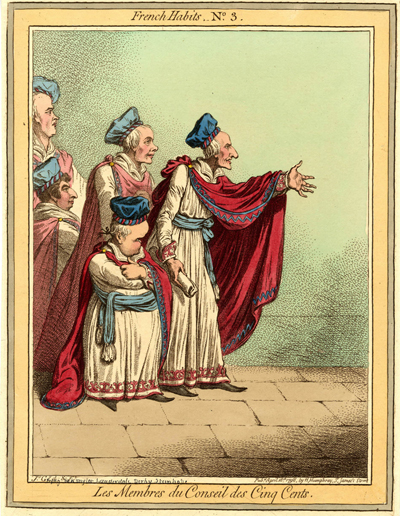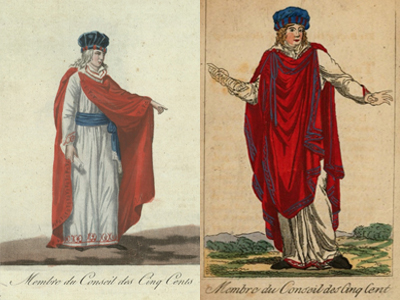French Habits: Les Membres du Conseil des Cinq Cents
This is the third in a series of twelve plates in which Gillray portrays members of the Whig opposition wearing the new ceremonial robes designed by Jacques-Louis David for the prominent public officials of the French Directorate.
According to the description in Dresses of the Representatives of the People (1797), the Council of the Five Hundred was responsible for framing the legislation that was then sent to the Council of the Ancients. In the Council of the Five Hundred,
genius has a full career; orators can give free scope to their imaginations, and may conceive and produce grand ideas, vast and useful projects.
For his version of the revolutionary Council of the Five Hundred, Gillray has chosen to show (from right to left) Earls Stanhope, Derby, and Lauderdale, Michael Angelo Taylor, and George Byng—all of them staunch defenders of France and the revolution in their respective houses of Parliament.

© Trustees of the British Museum
In front with his arm outstretched is Earl Stanhope who would have been familiar to Gillray's audience from the print and ballad The Noble Sans-Culotte (1794) "Occasioned by a certain Earl's styling himself a sans-culotte citizen in the House of Lords." But most recently, Stanhope had appeared as the central and most visible head at the foot of the bloody pike in Gillray's The Tree of Liberty Must be Planted Immediately! (1797)
Following him (in more ways than one) is Earl Lauderdale. According to the Dictionary of National Biography, Lauderdale was visiting France when "the attack was made on the Tuileries," and subsequently became friends with the French Girondist, Jacques Pierre Brissot. On his return to England, he strenuously opposed the war with France "and is said on one occasion to have appeared in the House of Lords 'in the rough costume of Jacobinism.' As he did with Stanhope, Gillray included Lauderdale's head at the base of his "Tree of Liberty."
Beside and below Lauderdale is the Earl of Derby who seems to have been a thoroughly undistinguished politician but a reliable vote for the Whigs. His completely unique profile was a gift to caricaturists and Gillray included him (as he does here) whenever he needed another immediately recognizable Whig.
Behind Lauderdale are two lesser known Whigs. The short one is Michael Angelo Taylor; the tall one, George Byng. Taylor had been a Tory until around 1792, but then switched to support Fox and the Whigs over Parliamentary reform. He had appeared right behind Sheridan in Gillray's The Daggger Scene (1792) and beside him as one of the mendicants in Blue and Buff Charity. . . (1793). He was a personal friend of the Prince Regent, appearing in The Presentation, or The Wise Men's Offering (1796) carrying a wicker cradle right behind a thoroughly inebriated Prince.
The last of the members of the Council of Five Hundred is George Byng. As mentioned in the British Museum commentary on this print, Lord Holland had identified this very tall Whig as Charles Grey. But one has only to compare the profile with the one in Gillray's Hackney Meeting to realize that the most common identification is also the correct one. In that print, Byng is addressing his Middlsex constituents and railing against the Pitt administration's Treason and Sedition bills.
The look of the robes in Les Membres du Conseil des Cinq Cents is mainly derived from the French specification in Collection des nouveaux costumes des autorités constituées, civils et militaires. Even the pose of Stanhope with his left arm outstretched and his right hand grasping papers is borrowed from the French illustration. But the blue border on Stanhope's cloak is closer to the English "translation."

of the Robes Prescribed for the Les Membres du Conseil des Cinq Cents [1796/97]
Sources and Reading
- Commentary from the British Museum on French Habits: Les Membres du Conseil des Cinq Cents.
- "Charles Stanhope, 3rd Earl Stanhope," Wikipedia
- "Edward Smith-Stanley, 12th Earl of Derby," Wikipedia
- "James Maitland, 8th Earl of Lauderdale," Wikipedia
- "Michael Angelo Taylor," Wikipedia
- "George Byng (1764–1847)" Wikipedia
- Collection des nouveaux costumes des autorités constituées, civils et militaires
- Dresses of the Representatives of the People. . .
- Thomas Wright and R.H. Evans, Historical and Descriptive Account of the Caricatures of James Gillray #187
- Thomas Wright and Joseph Grego, The Works of James Gillray, the Caricaturist; With the History of His Life and Times pp. 239-240.
NEXT: French Habits 4
Comments & Corrections
NOTE: Comments and/or corrections are always appreciated. To make that easier, I have included a form below that you can use. I promise never to share any of the info provided without your express permission.